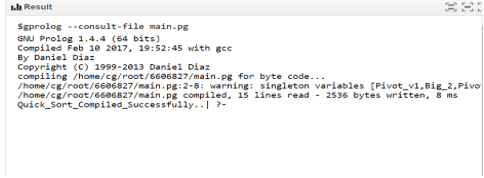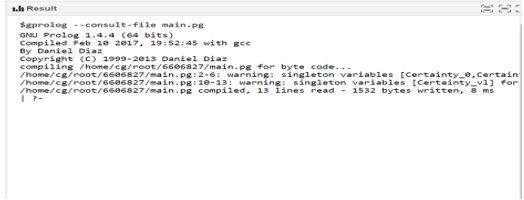Updated April 6, 2023

Definition of Prolog or
Prolog is a programming language that is in trend when it comes to logical operation. It is a logical programming language that majorly supports all the latest technologies like artificial intelligence or any computation linguistic-related languages. Prolog has its first logic with roots in a way with some formal language. Prolog is suited with logical operators which help in solving the complex logic problem by performing several queries. Prolog or is also considered a language with precedence having some of the rules alternatively called as; / logical or known as disjunction function as well.
Syntax
The Syntax flow goes in a way where the Flower_0 will be used for disjunction logic or operator where it will be used for making It fresh or if it becomes green in color then the approach for first flow comes as represented below.
Flower_0 (Y) :- fresh(Y) .
Flower_0(Y) :- green(Y) .Another syntax flow comes for the logical prolog or which is represented as follows:
Flower_1(X) :- fresh(X) ; green(X) .Another syntax representation is recommended more in the sense it will be used for making distinctions more attractive and enhanced by making the prolog follow its own rule with precedence and its corresponding rule.
How or works in Prolog?
- Prolog is a logical programming language comprised of two types of predicates associated with it where the Prolog or is knows as disjunction operator which will be used for making the relationship between the entities associated and dependent in some or the other way within it.
- Prolog as metadata is mostly used for logical and manipulative approaches due to which it makes use of declarative and procedural ways where the declarative way even in terms of or operator in Prolog will work in the sense it will be used for maintaining the relations between the attributes whereas the declarative type of logical programming declaration means how the determination of output from the prolog system will occur.
- Since disjunction is read as an or operator, it will be used for satisfying all the conditions related to it in the sense precedence used with these kinds of operators are used for binding with strongest then or not then which implies some of the complexity or anything else when it comes in making prolog or as a reason of contradiction.
- There is a special representation of Prolog or in the entire prolog programming language which is used for implementation and other development aspects thus, it is represented in the form of disjunctions with semicolon giving value as or.
- Basically, the working becomes successful where it mostly comprises of an infix operator with two arguments having goals such as goal1 and goal2 having a condition of if goal1 gets success then only goal2 will have success factor into the picture.
- Most often it is advisable to make use of parentheses() around the condition with logic as it makes use of the clear distinction between the interactive of conjunctions and disjunctions used among each other for manipulation.
- If in a scenario the parentheses get missed from the entire parentheses, then prolog has its own rule for logical which might not be the same as needed and the transition is required. Thus, everything present within parentheses is first taken care of than other attributes which are present outside. This makes the entire parsing and enhances the view or observation.
- Unless the predicate and hypothesis come out to be true then all its associated attributes or values will become vague without any significance. Therefore, it is very much needed to be in continuous usage of these operators as they help in sorting most of the problems with predicate and logic easily.
- Infix operator plays a significant role which makes it run and compile with some constraints and fixes that is quite important for any runtime compilation.
Examples
Different examples are mentioned below:-
Example #1
This program demonstrates the quicksort algorithm implementation using prolog or where the partition function is used with all these attributes for compilation and manipulation as shown below in the output.
partition_0([], _, [], []).
partition_0([X|Xs], Pivot_vl, Small_vl, Big_vl) :-
( X @< Pivot_v1 ->
Small_vl = [X|Rest_0],
partition (Xs, Pivot_vl, Rest_0, Big_vl)
; Big_2 = [X|Rest_0],
partition (Xs, Pivot_v2, Small_0, Rest_2)
).
quicksort_0([]) --> [].
quicksort_0([X|Xs]) -->
{partition_0(Xs, X, Smaller_0, Bigger_2) },
quicksort_0(Smaller_0), [X], quicksort_0(Bigger_2).
: - initialization(main).
main :- write('Quick_Sort_Compiled_Successfully..').Output:
Explanation:
In prolog language, loading code is known as consulting where the prolog is mainly used for a query to make the prolog prompt reflect the desired result once prompt comes up. If a scenario of multiple queries comes in, then there is usage of semicolon; to distinguish. Here in this example, a quicksort is performed to get the partition and implementation properly implemented within a hierarchy by making use of proper rules and assignments for the compilation of smaller and bigger elements.
Example #2
This program demonstrates the disjunction operator where the prolog language is making use of infix operator for easy read and modification, therefore, making the overall manipulation more enhanced in terms of segregation and some domain-related specifics as represented in the output.
solve_prb (true, 1) :- !.
solve_prb ((Sub_goal_1, Sub_goal_2), Certainty_0) :-
!,
solve_prb (Sub_goal_1, Certainty_1),
solve_prb (Sub_goal_2, Certainty_2),
Certainty_vl is min (Certainty_1, Certainty_2).
solve_prb (Goal_0, 1) :-
builtin(Goal_0), !,
Goal_0.
solve_prb(Head, Certainty_0) :-
clause_cf(Head, Body, Certainty_0),
solve_prb(Body, Certainty_2),
Certainty_vl is Certainty_0 * Certainty_2.’Output:
Explanation:
In this program, there is a sign of the attributes or say parameters passed from it like clause_cf contains Head, body, and Certainty_0 for a lot of meta-interpreters to be in the reasoning for uncertainty with many transformations in between but still internally making use of a lot of other functionalities and attributes behave in same. The main motto is to get the subgoals related or associated perfectly with the dependency mitigation and behaving.
Conclusion
Prolog or gels well when it comes to implementation with any of the programming related to logic. It makes the predicate and other functions also mutate and run properly. It has given developers an edge when it comes to performing operations and manipulations related to artificial intelligence or genetics algorithms where mainly logical programming comes into the picture.
Recommended Articles
We hope that this EDUCBA information on “Prolog or” was beneficial to you. You can view EDUCBA’s recommended articles for more information.



